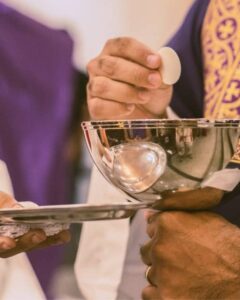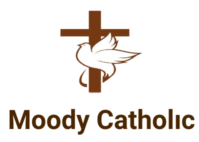Exploring The Significance of Chalice and Host In Christian Worship
Have you ever gazed upon a chalice and host, lost in the intricate details, rich history, and profound symbolism? The radiant gleam of the chalice juxtaposed with the humble simplicity of the host paints an image more potent than words.
In Christianity, these objects carry deep meanings. They’re not just ornate vessels or plain bread. They embody Jesus Christ’s self-sacrifice at his Last Supper—powerful symbols that have transcended centuries.
This journey will lead us down paths exploring their significance during Holy Communion, their diverse designs used across Christian worship, even decorating ideas for themed celebrations! As we venture into this realm together, expect to gain insights that may enhance your understanding and appreciation of these sacred items.
A sense of wonder is all you need as we embark on this exploration together—are you ready?
This blog post contains affiliate links. When you click on a link on this page and make a purchase I may earn a small commission, at no additional cost to you. Thank you for your support.
Exploring Different Types of Chalices and Hosts Used in Christian Worship
The chalice and host play significant roles in the celebration of Holy Communion, serving as symbolic representations of the Last Supper. Over time, various designs have emerged, each carrying unique cultural or religious implications.
The Ornate Design of Chalices
Many might wonder why such intricacy is found on a chalice used for Christian worship. The ornateness serves not just an aesthetic purpose but also symbolizes reverence towards the sacred act it facilitates – partaking in Jesus Christ’s blood during communion.
A notable example is the Chalice & Host Brass Tabernacle (item YC928), crafted with a hammered finish from solid brass. This piece stands out because its design features both elements – an ornate depiction of a chalice holding up what represents the body of Christ: a host.
Symbols carved onto these holy vessels often depict biblical narratives or saintly figures relevant to Christianity’s rich history. Therefore, beyond their functional use during mass services, they serve as visual narrations that engage worshippers into deeper reflection about faith’s essence.

Material Choices for Chalices
If you’ve ever been curious about what materials are preferred when crafting these crucial items for Christian worship ceremonies – we’ve got answers. Most commonly used metals include gold, silver, and bronze due to their durability and resistance against tarnish over prolonged use.
In fact, solid brass, like that employed in our previously mentioned YC928 tabernacle, has become increasingly popular thanks to its robustness paired with an attractive sheen that doesn’t fade quickly.
Moreover, the choice of these noble materials is symbolic in itself. The chalice’s gold or silver hue reminds us of Christ’s divine nature while its enduring strength reflects His everlasting love for humanity.
Understanding the Significance of Chalice and Host in Christian Religion
The chalice and host aren’t just symbols; they’re deeply meaningful in religion, standing for Jesus’ body (host) and blood (chalice). At the Last Supper, a concept was introduced that has had lasting implications.
The History and Origins of Chalice and Host in Christian Tradition
Jesus offered wine from a chalice saying “This is my blood,” thus initiating what Christians now commemorate as Holy Communion. The host – often a small wafer or piece of bread – represents Jesus’ body, given up for humanity’s salvation.
The Evolution Over Time
The origin of the chalice being used for wine can be traced back to its use at Jesus Christ’s Last Supper, as depicted in the New Testament. This meal, shared by Jesus Christ with his disciples on the eve of His crucifixion, holds a central place within Christian religion.
From Simple Vessels to Ornate Chalices
In early Christian communities, everyday items like simple cups and loaves were used during communion ceremonies. But over time these transformed into specialized objects signifying religious significance.
Somewhere around 200 A.D., evidence shows that specific vessels began being reserved solely for this purpose. By late antiquity period (300-600 A.D.), more ornately designed goblets started making appearances across different regions reflecting their increasing ceremonial importance.
The Transition from Bread Loaf to Hosts
Likewise, hosts too underwent changes over centuries within various sects of Christian religion. Originally starting off as pieces torn off large loaves baked specially for eucharistic celebrations morphed into uniform unleavened wafers we see today during holy communion rituals.
But why? Some theologians argue it was done primarily out practical reasons such as ease-of-use while others view it symbolically representing purity without yeast mirroring spiritual purity sought after through partaking in Eucharist ritual itself. Like this concept?
The Significance of Chalice and Host Today
Fast forward to the present day, chalice and host have become profound symbols within Christian worship. The priest raising the chalice during mass is a moment of reverence that echoes Jesus’ words at the Last Supper.
Specifically in Catholicism, this ritual does more than just remember Christ’s sacrifice. It also strengthens believers’ faith in transubstantiation – the belief that bread and wine transform.
The Importance of Chalice and Host in Maundy Thursday and Holy Week Celebrations
When it comes to Maundy Thursday, the chalice and host take center stage. They serve as a powerful reminder of Jesus Christ’s Last Supper, echoing His profound sacrifice.
This sacred ritual holds deep significance within Christian traditions during Holy Week.
Chalice and Host During Maundy Thursday
On Maundy Thursday, Christians commemorate the Last Supper where Jesus shared bread (the host) and wine (in the chalice) with his disciples. This event is central to our faith because it marks the institution of Holy Communion or Eucharist.
During this commemoration, priests use consecrated hosts kept in tabernacles since Good Friday from previous year’s services. The unleavened wafers are transformed into “Body of Christ”, symbolized by breaking one large wafer known as ‘Host’ into pieces while reciting words spoken by Jesus at Last supper – “This is my body”.
A Glimpse Into Rituals Involving Chalices
The “chalice”, filled with wine representing Christ’s blood shed for mankind’s redemption, plays an equally significant role on this day. It signifies unity in sharing suffering & joy amongst believers globally who participate through consuming consecrated elements believing them as actual Body & Blood of Christ that nourishes their spiritual life.
Symbolism Of Chalice and Host During Holy Week
As we navigate through the journey of Holy Week, each day is filled with its own spiritual symbolism. However, the role of chalice and host continues to be integral.
These two elements stand as symbols for Jesus’s act of self-sacrifice.
Conclusion
We’ve traveled far in understanding the chalice and host, diving deep into their religious significance. We explored how these symbols embody Jesus Christ’s self-sacrifice at his Last Supper.
Together, we unraveled diverse designs used across Christian worship—appreciating ornate chalices contrasting with humble hosts.
We delved into history, tracing back to Holy Communion’s origins and discovering traditions that have evolved over centuries.
Hasn’t this been a revealing voyage? Now you can gaze upon a chalice and host with an enriched perspective—one that goes beyond surface appearances to profound depths of symbolism!
Thank you for visiting my Moody Catholic blog. If you enjoyed reading this article please tell others by clicking on the share button in the lower right hand corner, right underneath the scroll to top arrow.
Looking for unique Catholic gifts? Check out our gift guide!

